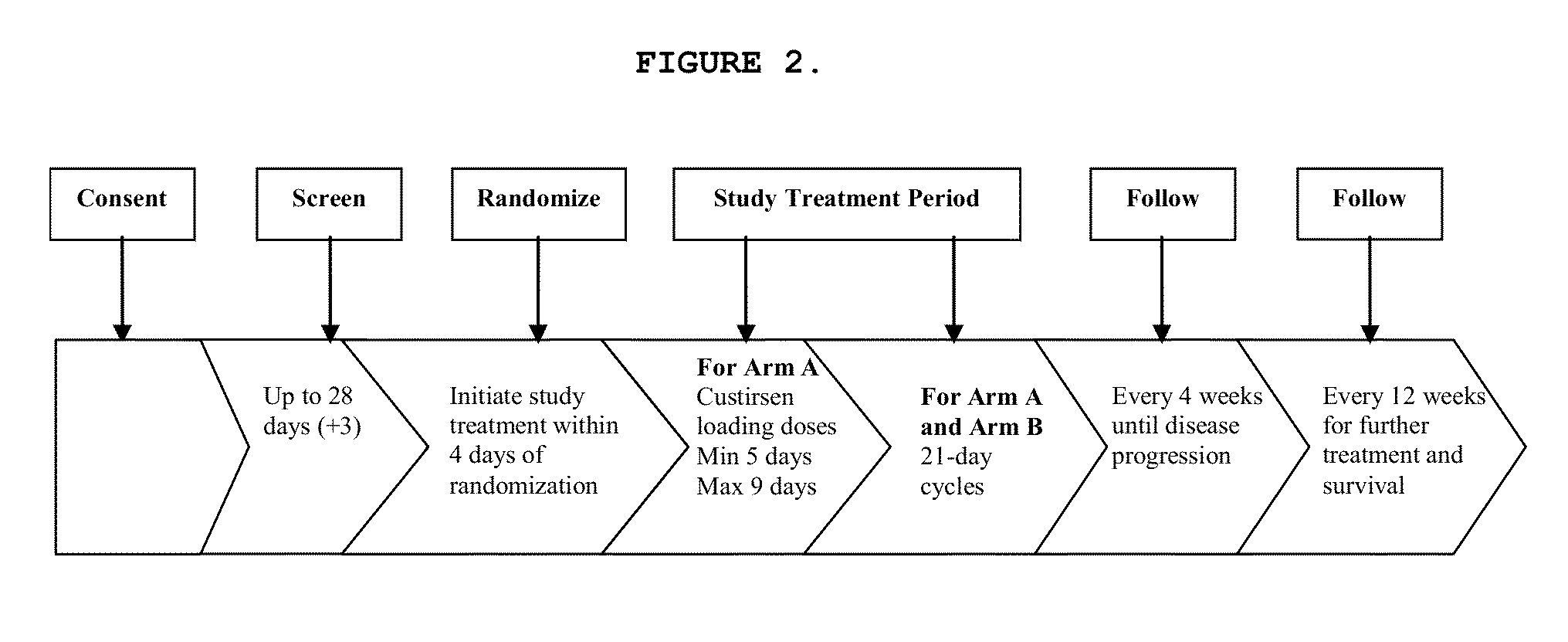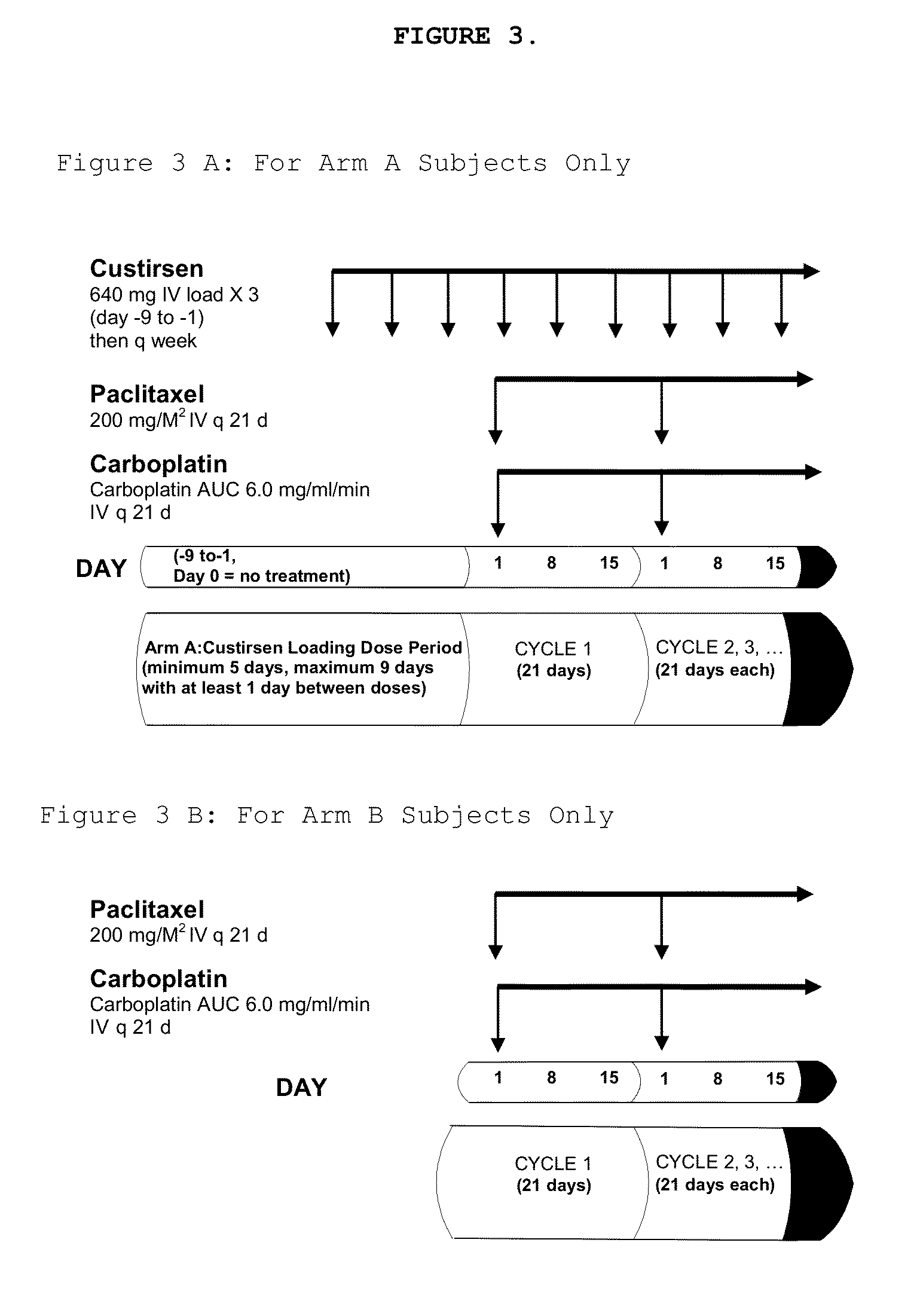Method for treating non-small cell lung cancer
a non-small cell lung cancer and treatment method technology, applied in the direction of drug compositions, organic chemistry, genetic material ingredients, etc., can solve the problems of cell death, the treatment of nsclc with a combination of carboplatin/paclitaxel and an anti-sense oligonucleotide has not been attempted, and the combination has not been described for the treatment of populations
- Summary
- Abstract
- Description
- Claims
- Application Information
AI Technical Summary
Benefits of technology
Problems solved by technology
Method used
Image
Examples
example 1
Clinical Trial (Phase III)—Assessment of Paclitaxel / Carboplatin in Combination with Custirsen in Preventing Progression of Non-Squamous NSCLC
[0433]A multinational, randomized, open-label phase III study comparing a standard first-line paclitaxel / carboplatin chemotherapy regimen to paclitaxel / carboplatin in combination with custirsen (TV-1011) is conducted to evaluate the safety, tolerability and efficacy in subjects with Stage IV non-squamous NSCLC.
Study Title
[0434]A Multinational, Randomized, Open-Label Phase III Study Comparing a Standard First-Line Paclitaxel / Carboplatin Chemotherapy Regimen to Paclitaxel / Carboplatin in Combination with Custirsen (TV-1011) in Subjects with Stage IV Non-Squamous Non-Small Cell Lung Cancer.
[0435]Subjects randomized to the custirsen arm first receive three doses of custirsen in a 5 to 9 day loading dose period prior to Day 1 of Cycle 1. Subjects randomized to both study arms have 21-day chemotherapy cycles until disease progression...
example 2
Correlation of Serum Clusterin Levels to the Duration of Individual Survival in NSCLC
[0547]In this Example, the baseline clusterin levels in patients receiving treatment within Arm A of Example 1 are analyzed and compared to clinical outcome. A subpopulation of these patients having a baseline clusterin level below 71 μg / mL are more likely to substantially benefit from anti-clusterin therapy compared to patients with baseline levels above 71 μg / mL. Specifically, patients with baseline clusterin levels below 71 μg / mL tend to survive longer than patients with baseline clusterin levels above 71 μg / mL. These data fit with a previous study (described herein below) that indicated a predictive threshold level of baseline clusterin in patient serum. Patients with baseline clusterin levels below this threshold were likely to benefit more from anti-clusterin therapy than patients with levels above the threshold.
[0548]The relationship between serum clusterin levels and the duration of individu...
example 3
Clinical Trial (Phase III)—Assessment of Custirsen in Combination With Docetaxel Versus Docetaxel For Treatment of Lung Cancer
Study Title
[0553]A Multinational, Randomized, Open-Label Phase III Study of Custirsen (TV-1011 / 0GX-011) In Combination With Docetaxel Versus Docetaxel As A Second-Line Treatment In Patients with Advanced or Metastatic (Stage IV) Non Small Cell Lung Cancer.
[0554]Patients randomized to the custirsen arm (Arm A) have 3 doses of custirsen administered in a 5 to 9 day Loading Dose Period prior to Day 1 of Cycle 1. Patients in Arm A receive custirsen on Days 1, 8 and 15, and docetaxel on Day 1 of the 21-day cycles. Patients in Arm B receive only docetaxel on Day 1 of the 21-day cycles. Patients randomized to both arms have 21-day chemotherapy cycles until disease progression, unacceptable toxicity, withdrawal of consent or protocol specified parameters to stop treatment.
Study Population
[0555]Patients with advanced or metastatic (Stage IV) non smal...
PUM
| Property | Measurement | Unit |
|---|---|---|
| Time | aaaaa | aaaaa |
| Time | aaaaa | aaaaa |
| Mass | aaaaa | aaaaa |
Abstract
Description
Claims
Application Information
 Login to View More
Login to View More - R&D
- Intellectual Property
- Life Sciences
- Materials
- Tech Scout
- Unparalleled Data Quality
- Higher Quality Content
- 60% Fewer Hallucinations
Browse by: Latest US Patents, China's latest patents, Technical Efficacy Thesaurus, Application Domain, Technology Topic, Popular Technical Reports.
© 2025 PatSnap. All rights reserved.Legal|Privacy policy|Modern Slavery Act Transparency Statement|Sitemap|About US| Contact US: help@patsnap.com



